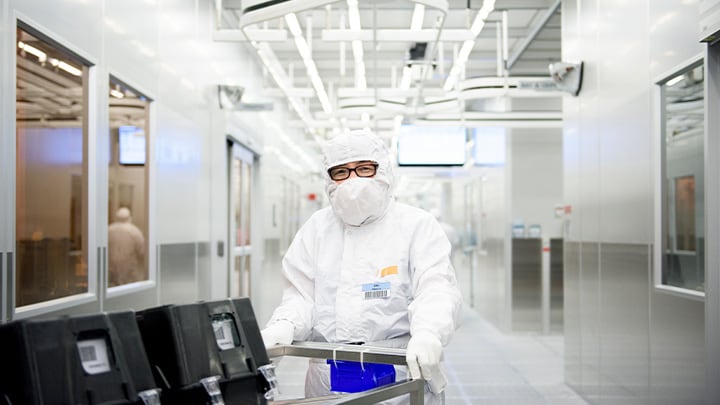Waste
We regularly review our processes and practices related to resource inflows and resource outflows to guide our efforts to make our business more circular.
Waste Aspiration
We continue to evolve our approach to the sourcing, consumption and disposal of materials critical to the manufacturing and testing of our products. We have set a mid-term goal of recycling 90% of our waste by keeping products and materials in use via reuse, resale, repurposing and recycling.
-
2027 Mid-Term Waste Target
- 90% of Waste Recycled
-
2024 Progress
- 89% of Waste Recycled
- 3% Decrease in Total Taste from 2023
Overview
We continue to collaborate with our supply chain to identify opportunities for waste reduction or alternative use and look for ways to reduce manufacturing waste by improving yield, optimizing processes and minimizing the waste of scrap material. As part of this approach, we do the following:
- Recycle/reuse spent materials, such as sulfuric-acid waste and then sell the materials to other companies for their use
- Expand our list of recycling vendors in local regions
- Identify recycling vendors who can recover precious metals from our e-scrap and finished product
- Replace single-use plastic in our cafeterias, cafés and pantries with sustainable and reusable alternatives
Waste by Method
We have waste-reduction management programs in place at our sites to handle hazardous and non-hazardous waste in an environmentally responsible manner and go beyond legal requirements.
For any waste that requires special handling, we ship it to vendors equipped with the knowledge and expertise to properly reclaim, recycle or destroy it. All our waste handling is done according to local rules and regulations.
We regularly audit our waste-management vendors to confirm they are meeting compliance requirements, handling waste responsibly and managing disposal with minimal impact to the environment.
Recycling Rate
We collect and recycle a variety of materials, including office waste (paper, cardboard and beverage containers), cafeteria waste (food and other compostable items), items from support operations (scrap metal, wood, coolant chemicals and calcium-fluoride cakes used in wastewater treatment) and manufacturing materials (spent acids and solvents, waste molding compound, plating hazardous waste, etc.).
In 2024, we recycled 89% of our total waste (hazardous and non-hazardous), an increase of 3 percentage points compared to 2023. Our recycling rate includes waste-to-energy activities, which involves the conversion of non-recyclable waste materials into usable heat, electricity or fuel through incineration. If we exclude waste-to-energy, the 2024 recycle rate is 80%. We increased the recycle rate by continuing to search for recycling vendors who can add to our recycling opportunities.
Innovative Waste Management
At NXP’s facility in Kaohsiung, Taiwan, 120 tons of molding scrap waste is transformed annually into eco-friendly resources - reducing CO2 emissions and pollution. The team is working with a third-party partner to recycle its mold scrap waste which gets a second life through innovative repurposing in numerous fields. A key aspect of molding scrap waste is silica. Silica can also be converted to an alternative for plastic. This reduces reliance on petroleum and bypasses the energy-heavy recycling of traditional plastics. The facility has achieved 100% recycling (including waste to energy), while processing remaining waste in innovative ways.

Contact Us
We are here to answer any inquiry regarding our corporate sustainability efforts, including EHS and environmental product compliance.